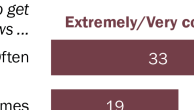
The rising price of gasoline replaced the Iraq war last week as the public’s most closely followed news story. More than half of the public (52%) paid very close attention to news about gas prices, and 27% said this was the single news story they followed more closely than any other. By comparison, 33% followed the situation in Iraq very closely, and 23% listed Iraq as their top news story of the week.
Historically, rising gas prices have attracted broad public interest. A year ago, even more Americans (69%) followed news about gas prices very closely. This past week, interest in gas prices outstripped media coverage of the issue by a wide margin. The national news media devoted 4% of its coverage to gasoline prices, making it the sixth most heavily covered news story of the week.
The public’s interest in gas prices goes beyond just knowing where to find the cheapest gallon of gas. A plurality of Americans (40%) say they are interested in learning about why gas prices are fluctuating nationally, while 30% want to hear about how rising gas prices are impacting the nation’s economy. Only about a quarter (24%) say they are mainly interested in knowing the price of gas in their area.

Two-thirds of Americans (67%) cite a media source as their main source of information about gasoline prices. Television is mentioned most frequently: 42% rely mainly on television news for information about gas prices; 13% newspapers; 7% the internet; and 5% cite radio news. Another 22% of Americans say they learn about the price of gas at their local gas station.
Interest in gas prices cuts across most major demographic groups, but some groups are following the subject more intensely than others. Fully 61% of those who have never attended college are following news about gas prices very closely, compared with 40% of college graduates. Older Americans are following the story more closely than are younger people (58% of those over age 50 vs. 48% of those under age 50 are following very closely). Democrats are somewhat more interested in news about gas prices than are Republicans (59% vs. 47%).
These findings are based on the most recent installment of the weekly News Interest Index, an ongoing project of the Pew Research Center for the People & the Press. The index, building on the Center’s longstanding research into public attentiveness to major news stories, examines news interest as it relates to the news media’s agenda. The weekly survey is conducted in conjunction with The Project for Excellence in Journalism’s News Coverage Index, which monitors the news reported by major newspaper, television, radio and online news outlets on an ongoing basis.
Iraq and Immigration Draw an Audience
Aside from gas prices, news about the Iraq war continued to draw considerable public interest. A third followed news about the situation in Iraq very closely, while 23% said it was the story they followed most closely. In addition, 30% paid very close attention to the debate in Washington over U.S. policy in Iraq, and 10% said this was the story they followed most closely.
More than a quarter of the public paid very close attention to the debate in Congress over new immigration policy, and 12% listed this as their top story. Hispanics followed this story slightly more closely than did non-Hispanics (34% vs. 26% very closely). Republicans and Democrats followed the story in roughly equal proportions. The media devoted 10% of its coverage overall to the immigration debate, putting it on a par with the Iraq policy debate and events on the ground in Iraq.

The 2008 presidential campaign drew very close attention from 22% of the public. This was the fourth-ranked story in terms of public interest. The national news media devoted 6% of its coverage for the week to the campaign. The bulk of the coverage was on television and radio. The campaign was not a top ten story last week for newspapers or online news sources.
The recent violence in Lebanon between militant groups and the Lebanese army received as much news coverage as the presidential campaign and more coverage than rising gas prices (6% overall). This was the second most covered story online, with online sources devoting 15% of their coverage to the conflict. However, the public paid relatively little attention to the events in Lebanon; just 15% followed the story very closely and 2% said it was the story they followed most closely last week.




